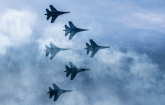
PUNE, India, Oct. 29, 2025 /PRNewswire/ -- A new, in-depth market analysis from Credence Research has identified a powerful growth trajectory for the Global Unmanned Helicopter Market, fueled by significant investments in defense technology and the rapid emergence of new commercial applications. The market, which was valued at USD 2,777.9 million in 2018, demonstrated remarkable growth to reach USD 5,893.6 million in 2024. This momentum is set to continue, with the market projected to achieve a valuation of USD 16,102.0 million by 2032, expanding at a strong compound annual growth rate (CAGR) of 13.47% during the forecast period from 2025 to 2032.
This impressive expansion is driven by the unique operational advantages of unmanned helicopters, particularly their Vertical Take-Off and Landing (VTOL) and hover capabilities, which make them ideal for a wide range of missions where runways are unavailable or precision is paramount. As global defense forces seek to enhance their intelligence, surveillance, and reconnaissance (ISR) and logistics capabilities while reducing risk to personnel, and as commercial sectors from agriculture to logistics look for more efficient solutions, the versatile unmanned helicopter platform is emerging as a critical technological asset.
Browse the report and understand how it can benefit your business strategy - https://www.credenceresearch.com/report/unmanned-helicopters-market
Market Overview
The Unmanned Helicopter Market comprises the design, manufacturing, and operation of rotary-wing Unmanned Aerial Vehicles (UAVs). Also known as rotary-wing drones or drone helicopters, these sophisticated aircraft are distinguished by their ability to perform vertical take-offs and landings, hover for extended periods, and operate in confined spaces without the need for a runway. This gives them a distinct advantage over their fixed-wing counterparts, which require runways and are designed for long-endurance, wide-area surveillance. Unmanned helicopters, in contrast, excel at missions requiring precision, close inspection, or operations from mobile platforms like naval vessels.
The market's robust growth, evidenced by its projected surge to over USD 16 billion by 2032, reflects a clear and accelerating demand for these versatile platforms across both military and civilian domains. In the defense sector, they have become indispensable assets for ISR missions, maritime patrol, target acquisition, cargo resupply to remote or contested areas, and communications relay. Their ability to launch from the small flight deck of a naval destroyer or operate in complex urban and mountainous terrain provides a level of operational flexibility that is unmatched by other systems.
In the commercial sphere, unmanned helicopters are carving out significant niches. Their capacity to carry heavy payloads makes them ideal for precision agriculture, where they can be used for large-scale crop spraying with high accuracy. They are also increasingly used for the detailed inspection of critical infrastructure such as power lines, wind turbines, bridges, and oil and gas pipelines. Other key applications include aerial mapping, filmmaking, and a burgeoning role in cargo logistics and last-mile delivery. The platform consists of several key components: the airframe, a powerful engine (combustion, electric, or hybrid), advanced avionics and flight control systems, a mission-specific payload (such as high-resolution cameras, LiDAR scanners, or cargo hooks), and a ground control station from which a remote pilot operates the aircraft.
Key Growth Determinants
Military Modernization and Persistent ISR Demand:
Global defense forces are increasingly integrating unmanned helicopters into their operational fleets to enhance their Intelligence, Surveillance, and Reconnaissance (ISR) capabilities. These platforms can be deployed from land or sea to provide persistent, real-time situational awareness without risking a pilot's life. Their ability to hover allows for focused observation of specific targets, while their VTOL capability is essential for naval operations from destroyers and frigates. This sustained demand for advanced, flexible ISR and logistical support is a primary driver of market growth.
Expansion into Commercial and Civil Applications:
Beyond the military, the market is being propelled by a widening array of commercial use cases. In precision agriculture, the heavy payload capacity of unmanned helicopters allows for the efficient spraying of large croplands. In the energy sector, they are used for the safe and cost-effective inspection of wind turbines and power lines. Other growing applications include aerial surveying and mapping, cargo delivery to remote sites, and public safety missions like search and rescue and wildfire monitoring. This diversification into high-value commercial services is creating significant new revenue streams.
Advancements in Autonomous Technologies and AI:
Rapid advancements in artificial intelligence, flight control systems, and sensor fusion are making unmanned helicopters more autonomous, reliable, and easier to operate. AI-powered algorithms enable complex maneuvers, automated obstacle avoidance, and target recognition, reducing the cognitive load on the remote pilot. These technologies are critical for enabling safe and efficient Beyond Visual Line of Sight (BVLOS) operations, which is the key to unlocking the full commercial and military potential of these platforms and is a major factor driving investment and adoption.
Key Growth Barriers
Complex and Restrictive Regulatory Frameworks:
The single greatest barrier to the commercial growth of the unmanned helicopter market is the complex and slowly evolving regulatory environment. Operating large, heavy UAVs, particularly Beyond Visual Line of Sight (BVLOS), in national airspace requires navigating a stringent and often lengthy certification process with aviation authorities like the FAA and EASA. The lack of standardized global regulations for BVLOS operations creates uncertainty and significant hurdles for companies seeking to deploy these platforms for commercial services like cargo delivery or large-scale inspections.
High Acquisition, Maintenance, and Operational Costs:
Unmanned helicopters are significantly more expensive than most fixed-wing UAVs or smaller multirotor drones. Their complex mechanical systems, including rotor heads, transmissions, and engines, require specialized and costly maintenance by highly trained technicians. This high total cost of ownership (TCO) can be prohibitive for many potential commercial operators and can strain the budgets of smaller defense organizations. The cost barrier remains a major factor limiting wider market adoption, especially in the price-sensitive commercial sector.
Concerns Over Safety, Reliability, and Public Perception:
The prospect of large, autonomous helicopters operating over populated areas or critical infrastructure raises significant public safety concerns. A mechanical or software failure in a heavy rotary-wing UAV could have catastrophic consequences. Ensuring extremely high levels of reliability through redundant systems and rigorous testing is essential. Public acceptance is a critical, non-technical barrier, and any high-profile accidents could lead to a public backlash and even stricter regulations, setting back the industry's progress for years.
Key Market Trends
Development of Hybrid-Electric Propulsion Systems:
A major technological trend is the shift towards hybrid-electric propulsion. These systems combine an internal combustion engine, which acts as a generator, with electric motors to drive the rotors. This approach offers the best of both worlds: the long endurance and heavy-lift capability of a fuel-powered engine, with the improved efficiency, reliability, and lower acoustic signature of electric propulsion. Hybridization is a key enabling technology for extending mission duration and range, making it a major focus of R&D for leading manufacturers.
Miniaturization and Platform Diversification:
While large unmanned helicopters designed for heavy-lift and long endurance dominate headlines, there is a concurrent trend towards the development of smaller, more tactical rotary-wing UAVs. These platforms, often weighing under 150 kg, offer the same VTOL and hover advantages in a more compact, portable, and rapidly deployable package. They are increasingly being used for applications such as urban surveillance, special forces support, convoy protection, and as "first-look" assets for first responders, broadening the overall market.
Integration of Advanced Multi-Sensor Payloads:
The true capability of an unmanned helicopter is defined by its payload. The current trend is to integrate increasingly sophisticated and diverse sensor suites and then use onboard AI to fuse the data. A single platform might carry a high-definition electro-optical (EO) camera, an infrared (IR) sensor for night operations, a LiDAR scanner for 3D mapping, and a communications relay package. This sensor fusion provides a multi-layered, comprehensive intelligence picture, transforming the platform from a simple "flying camera" into a powerful, real-time data collection and analysis node.
Key Opportunities
- Urban Air Mobility (UAM) and Middle-Mile Cargo Logistics: A massive future opportunity lies in the logistics sector, particularly for middle-mile cargo transport and time-sensitive deliveries. Unmanned helicopters are ideal for transporting goods between distribution hubs, resupplying offshore platforms, or delivering urgent medical supplies like organs and blood to hospitals. Their ability to take off and land vertically eliminates the need for airports, allowing for point-to-point delivery. As regulations mature to allow for autonomous cargo flights, this segment is expected to become a multi-billion dollar market.
- Maritime Surveillance and Ship-Based Operations: The maritime domain presents a perfect environment for unmanned helicopters. Their ability to operate from the small flight decks of naval and coast guard vessels dramatically extends the surveillance and operational reach of the host ship. They are ideal for over-the-horizon ISR, anti-piracy patrols, search and rescue missions, and monitoring vast Exclusive Economic Zones (EEZs). This opportunity is driving significant investment from navies around the world, as these platforms serve as a powerful force multiplier for any fleet.
- Large-Scale Precision Agriculture and Forestry: Unmanned helicopters offer a distinct advantage over smaller drones for large-scale agriculture and forestry management. Their capacity to carry hundreds of kilograms of payload allows them to efficiently spray pesticides or fertilizers, or to conduct aerial seeding, over vast tracts of land. They can apply treatments with high precision, which reduces chemical runoff and environmental impact. This capability to cover more ground, more quickly, and with heavier loads makes them a compelling value proposition for large agribusinesses and forestry companies.
Preview the report with a detailed sample and understand how it can benefit your business strategy. Request a free sample today - https://www.credenceresearch.com/report/unmanned-helicopters-market
Segmentation
Application Segments:
- Military
- Government Agency
- Industrial
- Others
End User Segments:
- Defense Agencies
- Law Enforcement
- Emergency Services
Based on the Geography:
- North America
- U.S.
- Canada
- Mexico
- Europe
- UK
- France
- Germany
- Italy
- Spain
- Russia
- Belgium
- Netherlands
- Austria
- Sweden
- Poland
- Denmark
- Switzerland
- Rest of Europe
- Asia Pacific
- China
- Japan
- South Korea
- India
- Australia
- Thailand
- Indonesia
- Vietnam
- Malaysia
- Philippines
- Taiwan
- Rest of Asia Pacific
- Latin America
- Brazil
- Argentina
- Peru
- Chile
- Colombia
- Rest of Latin America
- Middle East
- UAE
- KSA
- Israel
- Turkey
- Iran
- Rest of Middle East
- Africa
- Egypt
- Nigeria
- Algeria
- Morocco
- Rest of Africa
Regional Analysis
North America currently dominates the Global Unmanned Helicopter Market, primarily due to massive and sustained investment from the U.S. Department of Defense. Flagship programs, such as the Northrop Grumman MQ-8 Fire Scout for the U.S. Navy, have driven technological development and established a strong industrial base. The region is home to most of the world's leading manufacturers, and while commercial adoption is growing, it remains carefully managed by strict Federal Aviation Administration (FAA) regulations.
The Asia Pacific region is projected to be the fastest-growing market. This growth is fueled by ambitious military modernization programs in China, Japan, India, and South Korea, all of which are investing heavily in unmanned systems for maritime surveillance and border security. China has also emerged as a significant developer and exporter of unmanned helicopters for both military and commercial applications, further driving regional expansion.
Europe represents another key market, with a strong aerospace and defense industry. European nations are actively developing next-generation unmanned platforms for military, security, and civil applications. Regulatory bodies like the European Union Aviation Safety Agency (EASA) are at the forefront of creating comprehensive frameworks for integrating UAVs into civilian airspace, which is expected to unlock significant commercial opportunities across the continent in the coming years.
Credence Research's Competitive Landscape Analysis
The Global Unmanned Helicopter Market is characterized by a concentrated competitive landscape, dominated by major global defense and aerospace prime contractors. Industry titans such as Northrop Grumman Corporation, The Boeing Company, Lockheed Martin Corporation (through its Sikorsky division), Bell (a Textron Inc. company), and Airbus Helicopters are key players, leveraging their extensive engineering expertise, vast manufacturing capabilities, and long-standing relationships with government customers. The market also features highly successful specialized manufacturers, most notably Schiebel of Austria, whose CAMCOPTER® S-100 has achieved significant global success in both military and civil markets. Competition is intense and is primarily driven by technological superiority—in areas like endurance, payload capacity, and level of autonomy—as well as system reliability and the ability to secure long-term, high-value government contracts.
Key Player Analysis
- Elbit Systems
- CybAero
- Northrop Grumman
- MD Helicopters
- AVIC Helicopter Company
- Airbus Helicopters
- Leonardo
- Schiebel Group
- Lockheed Martin
- Yamaha Motor Company
Recent Industry Developments
- In May 2025, Airbus U.S. Space & Defense and L3Harris Technologies announced a strategic partnership to enhance the Airbus MQ-72C Logistics Connector, an unmanned variant of the UH-72 Lakota helicopter. The collaboration integrates L3Harris' advanced digital backbone and command systems, enabling rapid integration of third-party commercial hardware. This initiative supports the U.S. Marine Corps with a modular, open-systems platform for diverse logistics missions in challenging environments.
- In May 2025, Cyberlux Corporation partnered with Optical Knowledge Systems, Inc. (OKSI) to strengthen UAS operations in GPS- and RF-denied environments. By integrating OKSI's OMNISCIENCE autonomy suite into Cyberlux platforms, the collaboration enables autonomous navigation, target detection, and guidance without conventional communication systems, improving mission resilience in contested areas.
- In April 2025, HD Hyundai Heavy Industries (HD HHI) partnered with Anduril Industries to co-develop advanced unmanned surface vessels (USVs). The initiative combines HD HHI's autonomous navigation systems with Anduril's mission autonomy technology to create AI-driven naval platforms capable of complex operations with minimal human control.
- In January 2025, Redwire Corporation acquired Edge Autonomy for USD 925 million, expanding into the unmanned aerial systems (UAS) sector. The acquisition integrates Edge Autonomy's drone technologies with Redwire's space infrastructure solutions, enhancing defense and intelligence offerings while diversifying Redwire's national security portfolio.
- In June 2024, at the ILA Berlin Air Show, Airbus unveiled the VSR700 unmanned helicopter, designed for naval operations with advanced technology and operational flexibility. The same month, Biggen Technologies (BGT) showcased its unmanned helicopter lineup featuring electric, engine-powered, and multi-payload models, highlighting its innovation in aerial automation.
- In May 2024, Titra partnered with Airbus to adapt the ALPIN drone for naval use, enabling autonomous take-off and landing from maritime platforms.
- In April 2024, UAVOS deployed its UVH 170 unmanned helicopter to aid wildfire suppression by providing real-time data to firefighting agencies.
- In January 2024, Airbus Helicopters completed the acquisition of Aerovel, including its Flexrotor UAS, to expand tactical unmanned aerial capabilities. The same month, the UAE Ministry of Defence awarded EDGE a contract for 200 HT-100 and HT-750 unmanned helicopters to strengthen VTOL operations. Also, Turkey's ASELSAN delivered the first ASELFLIR-400 Electro-Optical Reconnaissance and Targeting System, enhancing indigenous surveillance capabilities.
- In January 2024, Hanwha Systems was selected to develop an unmanned helicopter for the Republic of Korea Navy and Marine Corps, improving naval reconnaissance and logistics operations.
- In November 2023, China inducted its first batch of unmanned maritime helicopters in Weihai, Shandong Province, to support water traffic control and maritime emergency response.
- In August 2023, AVIC's China Helicopter Research and Development Institute (CHRDI) designated the AR-500 unmanned helicopter for maritime management in Shandong Province, conducting surveillance, rescue, and pollution monitoring missions.
Reasons to Purchase this Report:
- Gain a comprehensive understanding of the market through qualitative and quantitative analyses, considering both economic and non-economic factors, with segmentation and sub-segmentation details provided in terms of market value (USD Billion).
- Identify regions and segments expected to experience the fastest growth or dominate the market, with a detailed analysis of geographic consumption patterns and the factors driving or hindering market performance in each region.
- Stay informed about the competitive environment, with rankings of major players, recent product and service launches, partnerships, business expansions, and acquisitions from the past five years.
- Access detailed profiles of major market players, including company overviews, insights, product benchmarking, and SWOT analysis, to understand competitive advantages and market positioning.
- Explore the present and forecasted market landscape, with insights into growth opportunities, market drivers, challenges, and constraints for both developed and emerging regions.
- Benefit from Porter's Five Forces analysis and Value Chain insights to evaluate various market perspectives and competitive dynamics.
- Understand the evolving market scenario, including potential growth opportunities and trends expected in the coming years.
Tailor the report to align with your specific business needs and gain targeted insights. Request Here - https://www.credenceresearch.com/report/unmanned-helicopters-market
Discover additional reports tailored to your industry needs
Commercial Helicopter Market https://www.credenceresearch.com/report/commercial-helicopter-market
Australia Firefighting Aircraft Market https://www.credenceresearch.com/report/australia-firefighting-aircraft-market
Aircraft Doors Market https://www.credenceresearch.com/report/aircraft-doors-market
Aerospace Composites Market https://www.credenceresearch.com/report/aerospace-composites-market
Aircraft Gearbox Market https://www.credenceresearch.com/report/aircraft-gearbox-market
Follow Us:
https://www.linkedin.com/company/credenceresearch/
https://www.facebook.com/CredenceResearch
About Us:
Credence Research is a viable intelligence and market research platform that provides quantitative B2B research to more than 2000 clients worldwide and is built on the Give principle. The company is a market research and consulting firm serving governments, non-legislative associations, non-profit organizations, and various organizations worldwide. We help our clients improve their execution in a lasting way and understand their most imperative objectives.
Contact Us
Credence Research Europe LTD
128 City Road, London,
EC1V 2NX, UNITED KINGDOM
Europe - +44 7809 866 263
North America - +1 304 308 1216
Australia - +61 4192 46279
Asia Pacific - +81 5050 50 9250
+64 22 017 0275
India - +91 6232 49 3207
[email protected]
www.credenceresearch.com
Logo - https://mma.prnewswire.com/media/2562161/5590673/Credence_Research_Logo.jpg
SOURCE Credence Research Inc.







Share this article